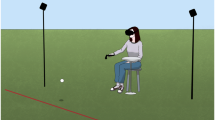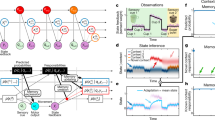Abstract
Memory organization should be at times persistent and at others flexible in the face of environmental perturbations. Unlike conceptualizations that bear on the reduction of the mismatch between the memory trace and the model, it is assumed here that changes in the memory system are governed by stability principles. Results of a bimanual coordination learning task indicated that (1) persistent memories are created and stabilized, when the competition between the preexisting (0 and 180° of relative phase) and the to-be-learned (90°) patterns leads to a qualitative change in the memory layout; (2) transient memories arise without stabilization, when the competition is weaker, leading to a temporary shift of an initially stable pattern (90°) toward the required value (135°). These findings call for further examination of the relationship between stability and memory persistence, which might give a new thrust to understanding its neural correlates.





Similar content being viewed by others
References
Brashers-Krug T, Shadmehr R, Bizzi E (1996) Consolidation in motor memory. Nature 382:252–255
Cardoso de Oliveira S (2002) The neuronal basis of bimanual coordination: recent neurophysiological evidence and functional models. Acta Psych 110:339–359
Debaere F, Swinnen S, Béatse E, Sunaert S, Van Hecke P, Duysens J (2001) Brain areas involved in interlimb coordination: a distributed network. Neuroimage 14:947–958
Fontaine RJ, Lee TD, Swinnen S (1997) Learning a new coordination pattern: reciprocal influences of intrinsic and to-be-learned patterns. Can J Exp Psychol 51:1–9
Giraudo MD, Pailhous J (1999) Dynamic instability of visuospatial images. J Exp Psychol Hum Percept Perform 25:1495–1516
Grimm V, Wissel C (1997) Babel, or the ecological stability discussions: an inventory and analysis of terminology and a guide for avoiding confusion. Oecologia 109:323–334
Haken H (1983) Synergetics: an introduction. Springer, Berlin Heidelberg New York
Jantzen KJ, Fuchs A, Mayville JM, Deecke L, Kelso JAS (2001) Neuromagnetic activity in alpha and beta bands reflect learning-induced increases in coordinative stability. Clin Neurophysiol 112:1685–1697
Jantzen KJ, Steinberg FL, Kelso JAS (2002) Practice-dependent modulation of neural activity during human sensorimotor coordination: a functional magnetic resonance imaging study. Neurosci Lett 332:205–209
Kelso JAS (1984) Phase transitions and critical behavior in human bimanual coordination. J Physiol Regul Integr Comp Physiol 15:R1000–R1004
Kelso JAS (1995) Dynamic patterns: the self-organisation of brain and behavior. The MIT Press, Cambridge
Kelso JAS, Zanone PG (2002) Coordination dynamics and transfer across different effector systems. J Exp Psychol Hum Percept Perform 28:776–797
Kostrubiec V, Zanone PG (2002) Memory dynamics: distance between the new task and existing behavioral patterns affects learning and interference in bimanual coordination. Neurosci Lett 331(3):193–197
Lee TD, Swinnen S, Verschueren S (1995) Relative phase alterations during bimanual skill acquisition. J Mot Behav 27:263–274
Levin O, Suy E, Huybrechts J, Vangheluwe S, Swinnen SP (2004) Bimanual coordination involving homologous and heterologous joint combinations: when lower stability is associated with higher flexibility. Behav Brain Sci 152:437–445
Newell KM, Slifkin AB (1998) The nature of movement variability. In: Piek JP (ed) Motor behavior and human skill: a multidisciplinary perspective. Human Kinetics, Champaign, pp 143–160
Paller KA (1997) Consolidating dispersed neocortical memories: the missing link in amnesia. Memory 5:73–88
Schöner G (1989) Learning and recall in a dynamic theory of coordination patterns. Biol Cybern 62:39–54
Schöner G, Haken H, Kelso JAS (1986) A stochastic theory of phase transitions in human hand movement. Biol Cybern 53:247–257
Schöner G, Kelso JAS (1988) Dynamic pattern generation in behavioral and neural systems. Science 239:1513–1520
Schöner G, Zanone PG, Kelso JAS (1992) Learning as change of coordination dynamics: theory and experiment. J Mot Behav 24(1):29–48
Shadmehr R, Brashers-Krug T (1997) Functional stages in the formation of human long-term motor memory. J Neurosci 17:409–419
Smethurst CJ, Carson RG (2001) The acquisition of movement skills: Practice enhances the dynamic stability of bimanual coordination. Hum Mov Sci 20:499–529
Squire LR, Zola SM (1997) Amnesia, memory and brain systems. Philos Trans R Soc Lond B 352:1663–1673
Tuller B, Case P, Ding M, Kelso JAS (1994). The non linear dynamics of speech categorization. J Exp Psychol Hum Percept Perform 20:3–16
Verschueren SM, Swinnen SP, Dom R, De Weerdt W (1997) Interlimb coordination in patients with Parkinson’s disease: motor learning deficits and the importance of augmented information feedback. Exp Brain Res 113:497–508
Wenderoth N, Bock O (2001) Learning of a new bimanual coordination pattern is governed by three distinct processes. Motor Control 1:23–35
Wenderoth N, Bock O, Krohn R (2002) Learning of a new bimanual coordination pattern is influenced by existing attractors. Motor Control 6:166–182
Zanone PG, Kelso JAS (1992) Evolution of behavioral attractors with learning: nonequilibrum phase transitions. J Exp Psychol Hum Percept Perform 18:403–421
Zanone PG, Kelso JAS (1994) The coordination dynamics of learning: theoretical structure and expérimental agenda. In: Swinnen S, Heuer M, Massion J, Casaer P (eds) Interlimb coordination: neural, dynamical and cognitive constraints. Academic Press, New York, pp 571–593
Zanone PG, Kelso JAS (1997) Coordination dynamics of learning and transfer: collective and component levels. J Exp Psychol Hum Percept Perform 23:1454–1480
Zanone PG, Kostrubiec V (2004) Searching for (dynamic) principles of learning. In: Jirsa VK, Kelso JAS (eds) Coordination dynamics: issues and trends. Springer, Berlin Heidelberg New York, pp 57–89
Author information
Authors and Affiliations
Corresponding author
Rights and permissions
About this article
Cite this article
Kostrubiec, V., Tallet, J. & Zanone, PG. How a new behavioral pattern is stabilized with learning determines its persistence and flexibility in memory. Exp Brain Res 170, 238–244 (2006). https://doi.org/10.1007/s00221-005-0208-6
Received:
Accepted:
Published:
Issue Date:
DOI: https://doi.org/10.1007/s00221-005-0208-6




